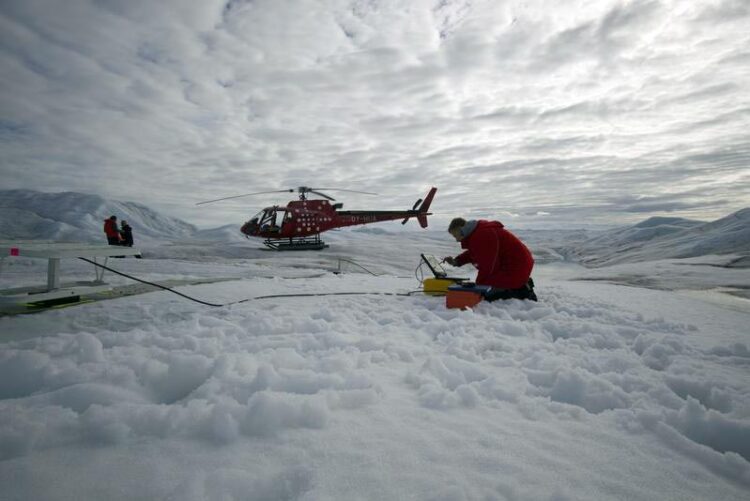Enormous Ice Loss from Greenland Glacier

Ole Zeising starting pRES (radar) measurement on 79 North Glacier
(c) Alfred-Wegener-Institut / Niklas Neckel
Ground-based measuring devices and aircraft radar operated in the far northeast of Greenland show how much ice the 79° N-Glacier is losing. According to measurements conducted by the Alfred Wegener Institute, the thickness of the glacier has decreased by more than 160 metres since 1998. Warm ocean water flowing under the glacier tongue is melting the ice from below. High air temperatures cause lakes to form on the surface, whose water flows through huge channels in the ice into the ocean. One channel reached a height of 500 metres, while the ice above was only 190 metres thick, as a research team has now reported in the scientific journal The Cryosphere.
A rustic camp in northeast Greenland was one of the bases for deploying autonomous measuring devices with modern radar technology by helicopter in a part of the 79° N-Glacier that is difficult to access. Measurement flights with the polar aircraft of the Alfred Wegener Institute, Helmholtz Centre for Polar and Marine Research (AWI) and satellite data were also incorporated into a scientific study that has now been published in the scientific journal The Cryosphere. This study examines how global warming affects the stability of a floating ice tongue. This is of great importance for the remaining ice shelves in Greenland as well as those in Antarctica, as instability of the ice shelf usually results in an acceleration of the ice flow, which would lead to a greater sea level rise.
“Since 2016, we have been using autonomous instruments to carry out radar measurements on the 79° N-Glacier, from which we can determine melt and thinning rates,” says AWI glaciologist Dr Ole Zeising, the first author of the publication. “In addition, we used aircraft radar data from 1998, 2018 and 2021 showing changes in ice thickness. We were able to measure that the 79° N-Glacier has changed significantly in recent decades under the influence of global warming.”
The study shows how the combination of a warm ocean inflow and a warming atmosphere affects the floating ice tongue of the 79° N-Glacier in northeast Greenland. Only recently, an AWI oceanography team published a modelling study on this subject. The unique data set of observations now presented shows that extremely high melt rates occur over a large area near the transition to the ice sheet. In addition, large channels form on the underside of the ice from the land side, probably because the water from huge lakes drains through the glacier ice. Both processes have led to a strong thinning of the glacier in recent decades.
Due to extreme melt rates, the ice of the floating glacier tongue has become 32 % thinner since 1998, especially from the grounding line where the ice comes into contact with the ocean. In addition, a 500-metre-high channel has formed on the underside of the ice, which spreads towards the inland. The researchers attribute these changes to warm ocean currents in the cavity below the floating tongue and to the runoff of surface meltwater as a result of atmospheric warming. A surprising finding was that melt rates have decreased since 2018. A possible cause for this is a colder ocean inflow. “The fact that this system reacts on such short time scales is astonishing for systems that are actually inert such as glaciers,” says Prof Dr Angelika Humbert, who is also involved in the study.
“We expect that this floating glacier tongue will break apart over the next few years to decades,” explains the AWI glaciologist. “We have begun to study this process in detail to gain maximum insight into the course of the process. Although there have been several such disintegrations of ice shelves, we have only been able to collect data subsequently. As a scientific community, we are now in a better position by having built up a really good database before the collapse.”
Wissenschaftliche Ansprechpartner:
• Dr Ole Zeising, phone: +49 471 4831-2407, email: ole.zeising@awi.de
• Prof Dr Angelika Humbert; phone: +49 471 4831-1834; email: angelika.humbert@awi.de
Originalpublikation:
Zeising, O., Neckel, N., Dörr, N., Helm, V., Steinhage, D., Timmermann, R., and Humbert, A.: Extreme melting at Greenland’s largest floating ice tongue, The Cryosphere, 2024. DOI: 10.5194/tc-18-1333-2024
Weitere Informationen:
http://awi.de/en/about-us/service/press/single-view/enormer-eisverlust-von-groen…
Media Contact
All latest news from the category: Earth Sciences
Earth Sciences (also referred to as Geosciences), which deals with basic issues surrounding our planet, plays a vital role in the area of energy and raw materials supply.
Earth Sciences comprises subjects such as geology, geography, geological informatics, paleontology, mineralogy, petrography, crystallography, geophysics, geodesy, glaciology, cartography, photogrammetry, meteorology and seismology, early-warning systems, earthquake research and polar research.
Newest articles

NASA: Mystery of life’s handedness deepens
The mystery of why life uses molecules with specific orientations has deepened with a NASA-funded discovery that RNA — a key molecule thought to have potentially held the instructions for…

What are the effects of historic lithium mining on water quality?
Study reveals low levels of common contaminants but high levels of other elements in waters associated with an abandoned lithium mine. Lithium ore and mining waste from a historic lithium…

Quantum-inspired design boosts efficiency of heat-to-electricity conversion
Rice engineers take unconventional route to improving thermophotovoltaic systems. Researchers at Rice University have found a new way to improve a key element of thermophotovoltaic (TPV) systems, which convert heat…



